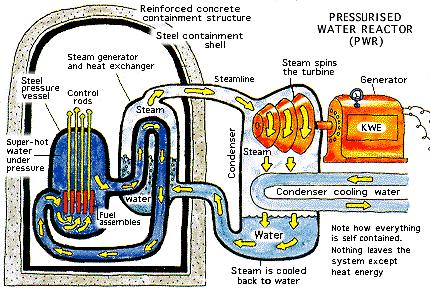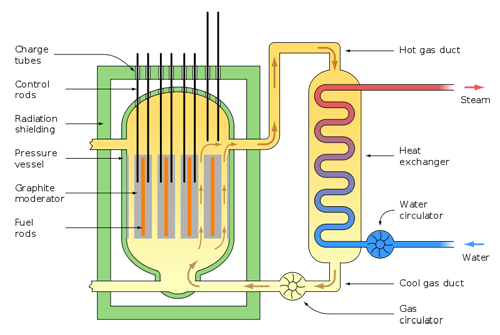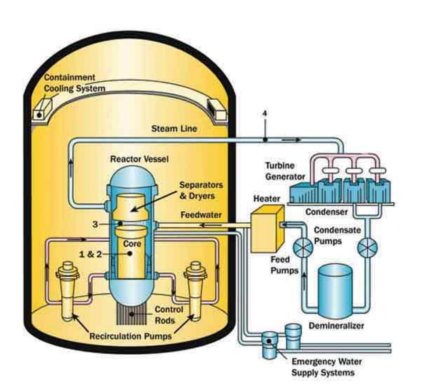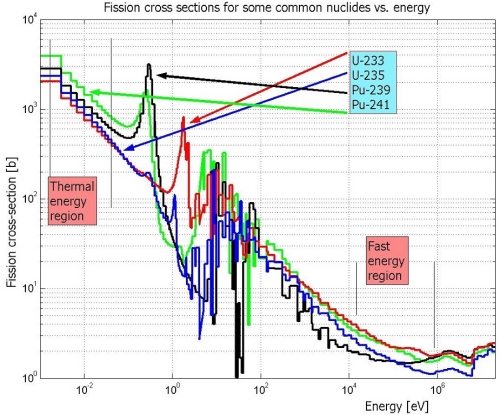- The Vitruvian Plant: Powering the Future #10-2284
-
Background
History of Nuclear Energy Nuclear Agencies and Regulations Nuclear Power in the Public Eye Economics of Nuclear Energy Radioactivity Basics Nuclear Reactor Basics Current Reactor Designs Processing Radioactive Materials Remote Handling Uses of Radiation Archimedes Filter Technology New Generation Reactors
- Components
- Project
Current Reactor Designs
There are several different designs for nuclear reactors. Most of them have the same basic function, but one's implementation of this function seperates it from another. There are several classification systems used to distingush between reactor types. Below is a list of common reactor types and classification systems found throughout the world.
Classified by Moderator Material
Light Water Reactor (LWR)
A light water reactor is a type of thermal reactor that uses “light water” (plain water) as a neutron moderator or coolant instead of using deuterium oxide (2H2O); light water reactors are the most commonly used among thermal reactors.Light water reactors are contained in highly pressurized steel vessels called reactor vessels. Heat is generated by means of nuclear fission within the core of the reactor. The nuclear fuel rods, each about twelve feet in length and about as thin as a pencil, are grouped by the hundreds into a “fuel assembly.” Each fuel rod contains pellets of an oxidized form of Uranium Triuranium Octaoxide (U3O8). A light water fuel reactor uses ordinary water to keep the system cool. The water is circulated past the core of the reactor to absorb the generated heat. The heated water then travels away from the reactor where it leaves the system as nothing more than water vapor. This is the method used in all LWRs except the BWR for in that specific system water is boiled directly by the reactor core.Graphite Moderated Reactor (GMR)
A Graphite Moderated Reactor is a type of reactor that is moderated with graphite. The first ongoing nuclear reaction carried out by Enrico Fermi at The University of Chicago was of this type, as well as the reactor associated with the Chernobyl accident. GMRs share a valuable property with heavy water reactors, in that natural un-enriched Uranium may be used. Another highlight for the GMR is a low power density, that is ideal if power were to suddenly stop; this would not waste as much power/fuel. The common criticisms for this design are a lack of room for steam suppression and the limited safety precautions available to the design.Heavy Water Reactor (HWR)
Heavy water reactors use a heavy water solution consisting of deuterium oxide(D2O) as a coolant and moderator . This differs from a light water reactor, for in a heavy water reactor un-enriched uranium may be used due to the deuterium oxide’s natural ability to split the un-concentrated atom. The ability to use un-enriched Uranium is economically cheaper in that it is more plentiful and requires less prep stages for reactor use. Main concerns regarding this reactor include moderator cost and large amounts of Pu-239 waste.Classified by Coolant Material
Pressurized Water Reactor (PWR)
A Pressurized Water Reactor is a type of light water reactor has been used for decades in designs by Westinghouse Bettis Atomic Power Laboratory for military ship applications, now the primary manufacturers are Framatome-ANP and Westinghouse for present day power plant reactors. The pressurized water reactor is unique in that although water passes through the reactor core to act as moderator and coolant it does not flow in to the turbine. Instead of the conventional flow cycle the water passes into a pressurized primary loop. This step in the PWR cycle produces steam in a secondary loop that drives the turbine. Advantages of the PWR include zero fuel leaks of radioactive material into the turbine or environment, and the ability to with stand higher pressures and temperatures to higher the Carnot efficiency. Disadvantages include complex reactor designs and costs. This reactor type accounts for the majority of reactors located in the U.S.Boiling Water Reactor (BWR)
Boiling water reactors date back to their General Electric introduction in the 1950’s. The distinguishing feature in the BWR is the boiling method for steam. IN this type of reactor water passes over the core as a coolant to expand and become steam source for a turbine placed directly above. Advantages of this design type include a simpler reactor design, a smaller reactor system, and lower costs. Disadvantages found are the increase of radioactive materials in the turbine and a greater chance for fuel to burn out as water quickly evaporates to expose fuel rods to an atmosphere absent of a coolant. BWRs have found fame all over the world due to the cheap simple design.Gas Cooled Reactor (GCR)
Gas cooled Reactors(GCR) are a type of GMR that use graphite as a moderator but CO2 or other inert gases as a coolant. The use of a gas gives the reactor better temperature and radiation stability. Because a gas is used rather than a liquid such as water the overall temperature can safely rise much higher to produce a greater plant efficiency, in some cases more than 40%.Another plus may be the life of the vessel material increases when it is not being worn and torn by chemical reactions that are commonly brutal with liquid coolants. Also, this reactor type is able to use natural Uranium, an advantage that appeals to cost and a shorter fuel production process. The only major issue associated with this plant type is the smaller power density in the reactor, which means more space is required to tap as much power as other reactor types.Classified by Reaction Type
Fast Neutron Reactor
Fast neutron reactors, also know as fast breeder reactors, use depleted nuclear waste as a form of energy. Uranium, which is composed of 0.7% Uranium-235 and 99.3% Uranium-238, is processed in the fast neutron reactors into isotopes of usable plutonium of plutonium 239 and 241. Fast neutron reactors are 60% more efficient than normal reactors; a fast neutron reactor uses liquid metal as its coolant as opposed to water, which makes the reactor safer to use and its fuel is metallic, which keeps the reactors under control more easily. Some cons of fast neutron reactors though are that they are very unpredictable, making them more tedious to use. Bubbles are more present in processes, so fast neutron reactors tend to heat up more rather than cool down and the coolant that it requires is much more exotic, such liquid sodium and bismuth eutectic.Thermal Neutron Reactor
Thermal reactors go through the same process as fast neutron reactors, but in a thermal reactor the process of obtaining plutonium is slower. In a thermal reactor the neutrons that undergo the reaction process have a significantly lower electron-volt energy, so the neutrons are considered to be slower. A neutron’s speed will determine its chances to interact with the nucleus of an atom; the slower its speed the bigger its fission cross section becomes and thus the higher its chance of interacting with the nucleus becomes.Advanced light-water reactor development in the United States
http://www.iaea.org/Publications/Magazines/Bulletin/Bull313/31304781317.pdf#
Boiling Water Reactor (BWR)
http://www.nucleartourist.com/type/bwr.htm
Carnot Efficiency
http://cryo.gsfc.nasa.gov/ADR/Carnot.html
Fast Nutron Reactors and Energy Dependence
http://www.americanenergyindependence.com/nucleargen4.aspx
Fuel Assembly Manufacturing
http://johncarlosbaez.wordpress.com/2010/10/05/power-density/
GE Energy - New Reactors
http://www.gepower.com/prod_serv/products/nuclear_energy/en/new_reactors.htm
Gas Cooled Reactors
http://www.nucleartourist.com/type/gcr.htm
Heavy Water
http://www.worldlingo.com/ma/dewiki/en/Schweres_Wasser
Heavy Water Reactor
https://netfiles.uiuc.edu/mragheb/www/NPRE%20402%20ME%20405%20Nuclear%20Power%20Engineering/Heavy%20Water%20Reactor.pdf
Making Bombs from Nuclear Waste
http://pathsoflight.us/musing/?p=195
NRC Glossary: Thermal Reactor
http://www.nrc.gov/reading-rm/basic-ref/glossary/thermal-reactor.html
Nuclear Chemistry - Nuclear Reactors
http://www.chemcases.com/nuclear/nc-10.html
Nuclear Reactors
http://www.scribd.com/Nuclear-Reactors/d/509207
Nuclear energy: principles, practices, and prospects
http://books.google.com/books?id=fCWKClWP_TwC&pg=PA460&lpg=PA460&dq=Graphite+moderated+Reactor&source=bl&ots=oygTVuTySb&sig=m4lwbEiz1CkaxhbqL8vEscAFtgg&hl=en&ei=Tt5qTdCAJ4edtweCk_imAw&sa=X&oi=book_result&ct=result&resnum=6&ved=0CD8Q6AEwBTge#v=onepage&q=Graphite%20moderated%20Reactor&f=false
RBMK Reactor
http://www.nucleartourist.com/type/rbmk.htm
Reactors, Cores & Reactor Vessels
http://www.nucleartourist.com/systems/rv.htm
The Moderation of Fission Reactions
http://hyperphysics.phy-astr.gsu.edu/hbase/nucene/moder.html#c1
Thermal, epi-thermal and fast reators
http://www.iri.tudelft.nl/~rooijen/spectra_en.html
Types of Nuclear Power Plants – Gas Cooled Reactors
http://www.brighthub.com/engineering/mechanical/articles/2498.aspx
Types of Nuclear Power Plants – Pressurized Water Reactors (PWR)
http://www.brighthub.com/engineering/mechanical/articles/2429.aspx
Types of Nuclear Reactors
http://hyperphysics.phy-astr.gsu.edu/hbase/nucene/reactor.html
Westinghouse Electric Company, LLC
http://www.westinghousenuclear.com/
What is a Fast Reactor
http://www.whatisnuclear.com/articles/fast_reactor.html
What is water vapor?
http://www.weatherquestions.com/What_is_water_vapor.htm




